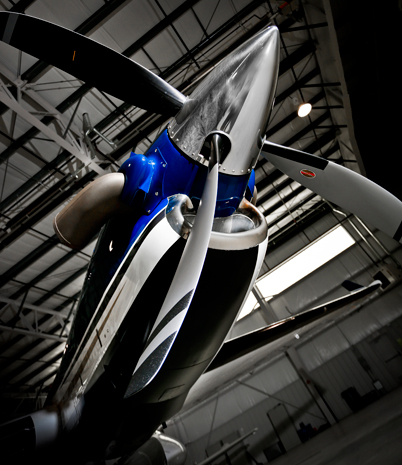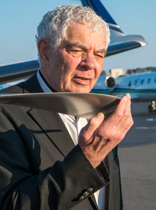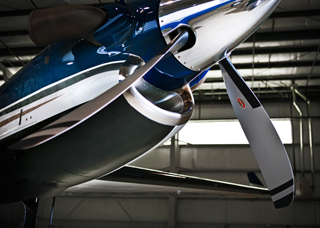Photography by Chris Rose

Of all the aftermarket-modification specialists available to turbine operators, James D. Raisbeck must certainly stand out as one of the most prolific. Raisbeck, CEO of Raisbeck Engineering of Seattle, Washington, started his company in the 1970s by developing performance-enhancing wing and flap modifications to the Learjets 35 and 36. By 1982 he was eyeing Beechcraft’s King Air line of twin turboprops. With thousands of King Airs in the active fleet, these airplanes were—and still are—ripe for simple mods that can provide disproportionately large increases in performance. At first he offered his expertise to the then-Beechcraft Corporation, only to be politely rebuffed.
Raisbeck said that back then, Beechcraft felt it would not be in the company’s best long-term interest to represent Raisbeck. How times have changed. For years, several Raisbeck modifications have been installed on King Airs—among them the models C90GTx, B200GT, 250, and 350—at the factory assembly line, and still others at Raisbeck- and Beechcraft-authorized service centers around the world.
“The King Air retrofit market is very juicy,” Raisbeck said, referring to profitability. “That’s because the design needs aerodynamic help, but there’s only a small number of innovations necessary, and I have no interest in reinventing the many good features of these airplanes.”
One of the first mods Raisbeck developed was a new leading edge design ($33,500) for a wing root extension that Beech added to its King Air 200s. This section is between the fuselage and the engine nacelles, and Raisbeck discovered that the wing leading edges in this area were so drooped that they caused not just drag, but airflow separation. During takeoff, as the airplane was rotated, the airflow reattached, causing a pitch-up as wing downwash increased on the elevator surfaces. Raisbeck’s mod not only stopped the pitch-up, but lowered stall speed and improved lateral stability at high angles of attack.
Newly designed landing-gear doors for the large-tire (high flotation) landing gear ($44,750) are another mod. The doors reduced drag by fully enclosing the tires and adding an extension to the underwing nacelle fairings. Aileron and flap seals were other Raisbeck offerings.
Dual aft-body strakes ($19,950) and wing lockers ($57,950) are other popular Raisbeck King Air mods. The strakes reduce drag by eliminating turbulent airflow under the fuselage, improve directional stability, increase climb rates, and eliminate or raise yaw damper limits. For example, the King Air models 200 and B200 call for yaw damper use when flying at or above 17,000 feet; with the strakes, this limitation doesn’t apply and these airplanes can fly right up to their maximum operating altitudes without using a yaw damper.

Raisbeck’s ram air recovery system ($41,950) is a mod that provides better engine air inlet seals for the King Airs’ Pratt & Whitney PT6A engines, as well as a dual ice-vane design that preserves the power ordinarily lost by deploying standard King Air ice vanes. The new vanes are installed at the Beechcraft factory as standard equipment on King Air 250s.
 Swept-blade propellers. Raisbeck’s latest offering is dramatic—a swept-blade propeller, dubbed Swept Blade Turbofan Propellers—designed for the King Airs 200, B200, and B200GT. Swept-wing theory is a subject unto itself, but suffice it to say that swept airfoils are optimal for minimizing drag when flying at transonic speeds (speeds just under the speed of sound). That’s because sweep yields two airflow vectors over an airfoil: one that’s perpendicular to the wing chord, and one that’s normal to the direction of flight. The combination of those two flow directions “fools” the wing into thinking it’s flying more slowly than it really is, and in the process minimizes the drag rise that accompanies transonic speeds, and increases performance.
Swept-blade propellers. Raisbeck’s latest offering is dramatic—a swept-blade propeller, dubbed Swept Blade Turbofan Propellers—designed for the King Airs 200, B200, and B200GT. Swept-wing theory is a subject unto itself, but suffice it to say that swept airfoils are optimal for minimizing drag when flying at transonic speeds (speeds just under the speed of sound). That’s because sweep yields two airflow vectors over an airfoil: one that’s perpendicular to the wing chord, and one that’s normal to the direction of flight. The combination of those two flow directions “fools” the wing into thinking it’s flying more slowly than it really is, and in the process minimizes the drag rise that accompanies transonic speeds, and increases performance.
Of course, propeller blades are airfoils; propeller tips can reach transonic speeds at high rpm; and the larger the propeller diameter, the faster the propeller tip speeds will be. So it is with unmodified King Airs.
“On the takeoff run, you can hear the tips stalling,” Raisbeck said. “By the time the airplane reaches 100 knots, the roots of the prop blades are turning at about 0.2 Mach, but at the tips the speed is very high—0.9 Mach. That’s what causes that buzzing, waaaah sound you hear.” Raisbeck calls up a YouTube video to demonstrate his point.
Because of the efficiencies of Raisbeck’s blade sweep, his mod produces 1,090-foot-shorter takeoff distances over standard 200-series King Airs; reduces accelerate-go distances by 3,450 feet; lowers VREF speeds by nine knots; and reduces landing distances by 530 feet. In its B200 application, the swept props reduce times to climb to 33,000 feet to 22 minutes (down from the standard B200’s 29-minute time to climb) and pushes max cruise speeds at 33,000 feet to 286 knots—13 knots faster than the unmodified 273 knots.

“In all, the swept props boost takeoff acceleration by an average of 14 percent over stock 200-series airplanes, engine-out climb rates are 88 fpm better than stock, and times to climb to 28,000 feet are improved by an average of 15 percent,” Raisbeck said. “And all of this with a blade diameter of 96 inches. Beechcraft original equipment propellers have 93-inch diameters. So we achieve better thrust and better performance thanks to the bigger props, but without increasing the noise level in the airplane or on the ground.”
The 2013 price for the swept-blade propellers is $83,400 per shipset. When combined with other Raisbeck King Air 200-series mods in a package called EPIC Platinum, the price is $149,850. This package includes the wing root mod, the aft body strakes, and the ram air recovery system.
An EPIC package that adds wing lockers and high-flotation gear doors to the mix runs $235,150. These prices represent savings of $28,550 and $46,350, respectively, over individually purchased modifications.
This isn’t the first time that Raisbeck has developed aftermarket propellers for King Airs. His Power Prop mod—which is still offered ($74,500 per shipset)—is a 94-inch-diameter design with blades that extend deep into the propeller root. Stock propellers have round roots that deny optimal thrust levels.
At this writing, the first swept-blade propeller installation had already been completed, and four more shipsets had been delivered. Seems that Raisbeck—who began his career at Boeing, went on to Robertson Aircraft, then Gates Learjet and Rockwell International—continues his string of successes. With 3,651 airplanes fitted with at least one Raisbeck mod, the King Air line has been his most popular market.
“And,” he adds with a flourish, “guess how many airworthiness directives we’ve had over the years—none!”
Email [email protected].



